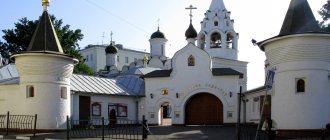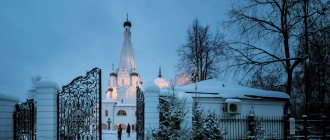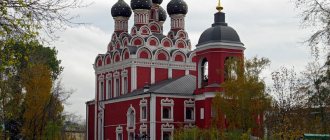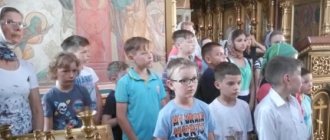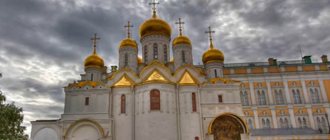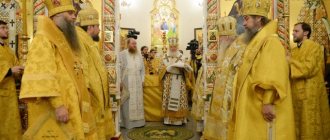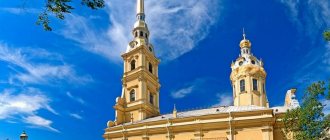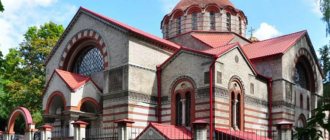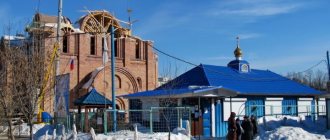"Save me, God!".
Thank you for visiting our website, before you start studying the information, please subscribe to our Orthodox community on Instagram, Lord, Save and Preserve † - https://www.instagram.com/spasi.gospodi/. The community has more than 60,000 subscribers. There are many of us like-minded people and we are growing quickly, we post prayers, sayings of saints, prayer requests, and timely post useful information about holidays and Orthodox events... Subscribe. Guardian Angel to you!
A temple is considered a certain place where a person can come to communicate with the Lord and turn to him with his prayers. Orthodox people visit such places in moments of joy and sorrow. There a person can be alone with himself and, with the help of God, get on the right path. The largest number of temples are located in large cities, where the population is larger than in villages. And this provokes the emergence of new sacred places. So in Moscow there are many churches and cathedrals, but the ancient buildings attract the most attention. These include the Temple of Dmitry of Thessalonica on Blagush.
History of the temple
It was founded in 1908-1911. Named in honor of Dmitry Thessalonica, who was the patron saint of Orthodox warriors. Blagusha is an area located in the northeast of Moscow. At the end of 1910, the first rector appeared in the temple. On June 29, 1911, the new church was consecrated and the first Liturgy was celebrated. This temple was not allotted a long century of existence. The same painful fate awaited him as his patron.
The architecture of the Temple of Demetrius of Thessalonica on Blagush combines Greek and Russian methods of temple construction. The number of parishioners that can accommodate is 3000. The main altar is named in honor of Dmitry of Thessalonica.
The best article for you, go to: Novodevichy Convent in St. Petersburg
There are also other limits:
- Saint Peter,
- Righteous Anna.
In 1931, the temple was closed, and the building itself was handed over to the NKVD. It was converted into a precious metals recycling plant. Crosses, domes, and bells were removed. Only in 1991 the temple was returned to the Russian Orthodox Church in a very abandoned state. It was ruined and cut off from all city communications. On November 17, 1991, the revival of the monastery began. Also on this day, crosses were consecrated and installed on the temple.
Already in 2001, services were held on the main altar. People, as well as children, flocked to this holy place. A Sunday school was opened. On November 8, 2007, on the day of memory of Dmitry of Thessalonica, the first Patriarchal service was held.
Temple of the Holy Great Martyr Demetrius of Thessalonica - history of creation and development
The design of the Temple of Demetrius of Thessalonica was created by the architect Orlov, who was personally acquainted with Ermakov and was a member of his house.
By sovereign decree in 1906, the Religious Department was allocated a plot of land for the construction of the sanctuary, and already in 1908 the first construction work began.
Soon a tented chapel with a golden cross rose in front of the main entrance, and behind it a four-tiered bell tower.
The Church of Demetrius (Dmitry) of Thessalonica on Blagush was built of unsanded red brick, decorated with green tiled ornaments.
There were three altars in the temple: the main altar - in memory of Demetrius of Thessalonica, the northern altar - dedicated to the Dormition of St. Righteous Anna, and the southern altar - in honor of Metropolitan Peter of Moscow.
This was the last will of the philanthropist Ermakov.
Schedule of services
The schedule of services of the Church of Demetrius of Thessalonica on Blagush has its own specific parish traditions:
- Litiya is held on Saturday evenings.
- On holidays, communion is given from three cups at once in order to avoid creating a queue.
- Confession on Saturday begins with the beginning of the All-Night Vigil.
- During Great Lent, crosses, larks, and ladders are baked during the Week of the Cross.
- At Christmas and Easter, parishioners and everyone else are treated to tea and sandwiches.
- On Easter, children and adults are allowed to ring the bell tower.
The best article for you, go to: Church of the Resurrection of the Word on the Assumption Vrazhek
Temple under the Soviets and today
In 1931, the temple building fell into the hands of the NKVD and turned into a plant for processing precious metals: there were smelting furnaces in the altar, and an acid workshop was located under the arch of the church.
After some time, the authorities intended to demolish the church. Fortunately, this was avoided.
In 1991, when the temple was returned to the Orthodox Church, it found itself in a pitiful and deplorable state.
Today, the Church of Dmitry of Thessalonica, located at Moscow, Ibragimova, 6, is one of the architectural, historical and spiritual attractions of Moscow.
Postal address: 143423 MO, Krasnogorsk district, p/o Petrovo-Dalneye, village. Dmitrovskoe, 43
Phone: +7-916-188-41-30
Travel by public transport:
1. From the Kuntsevskaya station by bus No. 452 to the village of Dmitrovskoye; 2. From the Pavshino station by bus No. 34 to the village of Dmitrovskoye; 3.From the Odintsovo station by bus No. 36 to the village of Dmitrovskoye.
Story:
The ancient village of Dmitrovskoye has been mentioned in chronicles since the 16th century, when it was listed behind the Trinity-Sergius Lavra. In 1677, Tsar Fyodor Alekseevich granted the village of Dmitrovskoye in the Goretovo camp to Prince Yuri Dolgoruky “for his many services, which the evil plans of the thief and apostate Stenka Razin with like-minded people eradicated him in the lower cities...”. After the death of Dolgoruky's son in 1683, the village was granted to Patriarch Joachim.
In 1689, a stone one-domed church with chapels and an octagonal hipped bell tower on a two-tiered base enclosing the so-called Nikon’s cell was built here. According to legend, the patriarch stopped there on his way to the Savvino-Storozhevsky Monastery. The architectural monument with its complex brick decoration, almost completely covering the walls of the building, the dome drum and the bell tower tent, is extremely characteristic of the patterned style. Window casings are varied in shape, of which the design of the casing with “horns” on the southern wall is especially interesting.
The elegance of the external appearance of the temple is enhanced by its two-tone coloring. The finishing touches on the facades are decorative kokoshniks and a wide cornice strip with whitewashed brick pattern details that look like a lace cape thrown over the building against the red background of the walls. The latest three-tier bell tower in the classicist style hides the entrance portal to the low vaulted refectory. In its depths, through an arched doorway, a gilded multi-tiered iconostasis gleams, containing a number of icons by masters of the 18th and 19th centuries.
Thrones:
The main throne was consecrated in honor of the Great Martyr. Demetrius of Thessalonica.
Revered icons:
Holy Martyr Demetrius of Thessalonica, icon of St. Nicholas the Wonderworker, icon of St. Seraphim of Sorov, holy martyr. Panteleimon.
Particles of relics:
None.
Affiliated churches, chapels:
None.
Divine services:
Divine services in the temple are held regularly: Saturday from 16.30 to 20.00, Sunday from 8.00 to 12.00; on holidays: the day before from 16.30 to 20.00, on the day of the holiday from 8.00 to 12.00. On Easter, Christmas and Epiphany the temple is open all day.
Bishop's services:
On October 19, 2021, the Divine Liturgy was led by Archbishop Feognost of Kashira
On November 8, 2021, Bishop John of Domodedovo led the Divine Liturgy in the Church of the Great Martyr. Demetrius of Thessalonica in the village. Dmitrovskoe
On November 8, 2021, Bishop Savva of the Resurrection celebrated the Divine Liturgy in the church in honor of the Great Martyr. Demetrius of Solunsky in the village of Dmitrovskoye
On November 8, 2013, Bishop Savva of the Resurrection celebrated the Divine Liturgy in the church in honor of the Great Martyr. Demetrius of Solunsky in the village of Dmitrovskoye
On August 11, 2012, Bishop Savva of the Resurrection celebrated an all-night vigil in the Church of the Great Martyr Demetrius of Thessaloniki in the village of Dmitrovskoe
Clergy:
The rector is Abbot Peter (Eremeev); cleric - Archpriest Mikhail Igorevich Isaev.
Website:
https://dimitrovskoe.ru
Church of St. Vmch. Demetrius of Thessalonica on Blagush
A temple is a place of people’s prayer to God, it is the house of God. The temple, built in 1908-1911 on Blagush, was named in honor of the holy great martyr Demetrius of Thessaloniki, the patron saint of Orthodox soldiers. Blagusha is the historical name of an area located in the north-east of Moscow between the Semenovskaya outpost and the village of Izmailovo. By the end of 1910, the Temple found its first rector. It was 42-year-old priest Mikhail Preferencesov. On June 29, 1911, Metropolitan Vladimir of Moscow consecrated the newly built Temple and celebrated the first Divine Liturgy in it. The new Temple did not last long. He faced the same path of martyrdom that his heavenly patron, the Holy Great Martyr Demetrius, walked. The temple was built in the spirit of eclecticism and is a combination of Greek and Russian methods of temple building. It can accommodate up to 3,000 parishioners. The main altar was consecrated in honor of the Holy Great Martyr Demetrius of Thessalonica; limits in honor of St. Peter, Metropolitan of Moscow, and the Assumption, in honor of Righteous Anna, mother of the Most Holy Theotokos. Architecturally, the Temple is a combination of a three-nave basilica and a cross-domed Temple, that is, a combination of Greek and Russian principles of temple building, symbolizing the unity of the spiritual feat of the Great Martyr Demetrius of Thessalonica and the Holy Blessed Prince Demetrius of Donskoy. In 1931, the parish was closed, and the Temple building was transferred to the jurisdiction of the NKVD, which adapted it into a plant for recycling precious metals. Crosses were demolished, domes were removed, and the upper tiers of the bell tower were dismantled. Melting furnaces were installed in the altar. An acid shop was placed under the main vault. In a completely ruined state, cut off from all city communications, the Temple building was returned to the Russian Orthodox Church in 1991. Since November 17, 1991, when the crosses were consecrated and installed on the Temple, the parish has been working to revive the Temple. At the Diocesan Assembly in 2000, Patriarch Alexy II of Moscow called the Temple of Demetrius of Thessalonica the most destroyed Temple in Moscow. The temple was built very quickly, it was revived, something new happened every day, and already in the fall of 2001, on the patronal feast day, the service began to be performed on the main altar. When the service began to take place every day, many people flocked to the Temple. The Sunday school was restored, the Temple began to be filled with children. Now Sunday school is a home in which children and adults feel the connection between the Church and the world. In our Temple there is a preschool group, primary school students, and a youth group. The classes are taught by Father Alexy Mityushin. The main goal of the classes is conversations through which children become churchgoers and gain basic knowledge about the Orthodox faith and culture. There is also a Sunday school for adults, taught by Father Igor Ivanov. On November 8, 2007, on the day of remembrance of the Great Martyr Demetrius of Thessalonica, His Holiness Patriarch of Moscow and All Rus' Alexy II celebrated the Divine Liturgy in the Church of the Great Martyr. Demetrius on Blagush. This was the first Patriarchal service in the restored Temple. There are a lot of children in the parish; on Sundays they receive communion from three Chalice. Patriarch Alexy II was amazed at the number of children, he himself gave communion to only the children for half an hour, and then went into the altar and handed over the Chalice, he was amazed, he had never seen so many children. It should be noted that all this is due to the fact that in our Temple, despite some little things, the attitude towards parishioners is friendly. The parish lives according to the instructions of both the Holy Saints of God and the late His Holiness the Patriarch. The temple is almost ready, we just have to make the right and left borders, paint the walls, but, unfortunately, this is not yet possible due to fungus on the walls. The Temple already has its own parish traditions. Every Saturday evening a lithium is celebrated; on holidays, priests try to administer communion from three chalices to make it easier to receive communion; confession on Saturday begins with the beginning of the All-Night Vigil, so that everyone has time to confess; in Lent, crosses are baked for the Week of the Cross, larks are baked for the 40 Martyrs of Sebastia, and “ladders” are baked for St. John the Climacus; on Christmas and Easter in the Temple everyone is fed sandwiches with tea; On Easter, all adults and children can ring the bell tower. The Sunday school also always celebrates children's holidays, and the Orthodox Historical Fencing Club organizes theatrical performances. The temple is the “House of God”, in which special grace resides. The soul must cling to at least the edge of the cross raised above the Temple. Our Temple is not only a place where Orthodox residents gather for prayer, for our parishioners the Temple has also become an important center of social life, and for residents of the Sokolinaya Gora region it has also become a local landmark. Use the menu on the left to learn more about the past and present of the parish of St. Vmch. Demetrius of Thessalonica.
Temple address: Moscow, st. Ibragimova, 6
Activities of the parish[edit]
Interior of the temple
Sunday school[edit]
The school has preschool, children's, teenage, youth and adult groups. Students study the Law of God, the Holy Scriptures of the Old and New Testaments, and the history of the Church. Classes are held in live communication with students. Particular attention is paid to patriotic education. After classes, students drink tea. On Christmas, Maslenitsa, Easter and other days, festive events are held for children and adults. Excursions and pilgrimages to holy places take place regularly.
Social service[edit]
There is a social service group at the temple.
The main areas of the group’s work are supporting children from boarding school No. 53, providing assistance to seriously ill and single citizens, and large families.
Those who want to work for the Glory of God can contact the temple social worker Anna Nikolaevna Arshinova, phone
,
e-mail:
Sights of Moscow openmoscow.ru
Church of the Great Martyr Demetrius of Thessalonica on Blagusha Ibragimov St., 6a, metro station "Semyonovskaya"
The Church of the Great Martyr Demetrius of Thessaloniki on Blagush is one of two churches dedicated to the Holy Great Martyr Demetrius of Thessalonica, the patron saint of Orthodox soldiers.
Built in 1908-1911. in Moscow, behind the Semenovskaya outpost, on Blagush. In 1905, residents of the Blagusha tract petitioned Metropolitan Vladimir of Moscow to appoint a special clergyman to the church at the Semyonovskoye cemetery who could care for the Blagushin parishioners. Metropolitan Vladimir invited the residents of Blagushi to build their own church and use for its construction part of the amount donated to the Spiritual Department in 1896 by Dimitry Florovich Ermakov. Hereditary Honorary Citizen D. F. Ermakov donated about one hundred thousand rubles for the construction of the temple, with the condition of dedicating it in honor of his heavenly patron, the Holy Great Martyr Demetrius of Thessaloniki and Holy Righteous Anna, in memory of the heavenly patroness of his wife. This money was part of the inheritance received by Dmitry Florovich from the father of the Moscow merchant Flor Yakovlevich Ermakov, known for his charitable activities in relation to many churches and monasteries in Russia. Using his millions, two almshouses were built in Moscow for peasants of both sexes of the Orthodox faith: Mariinskaya behind the Trekhgornaya Zastava (Shmitovsky Proezd, 29), Aleksandrovskaya in Sokolniki (Korolenko St., 2/23). The money left by the will of Dimitri Florovich Ermakov became the initial capital for the construction of this temple. According to the Highest Decree of the Sovereign Emperor Nikolai Alexandrovich of June 21, 1906, the Spiritual Department was given a plot of land on the corner of Mikhailovskaya (now Shcherbakovskaya Street) and Mochalskaya (now Ibragimov Street) streets for the construction of a church and clergy houses on this site. The plan and drawings of the future temple were made by the architect Nikolai Ivanovich Orlov, who worked as a staff architect at the Ermakov Almshouse in Sokolniki and was personally acquainted with members of the Ermakov family. According to the design of N.I. Orlov, the old building of the Kursk station in Moscow was also built, part of which has survived to this day. On August 16, 1909, the foundation stone of the temple was carried out. The temple was built in the spirit of eclecticism and is a combination of Greek and Russian methods of temple building. On the western side, in front of the main entrance to the church, there was a hipped chapel made of red brick with green tiled inserts, crowned with a gilded dome with a cross. The bell tower was four-tiered, its height was about 50 meters. Along the perimeter of the temple, the brickwork was decorated with green tiles. The red brick facades were not plastered. There were brick passage gates on the north and south sides of the temple. The Temple of Demetrius of Thessalonica was consecrated on June 29, 1911. The project included the construction of an almshouse for blind elders near the church, which was built by 1913. The temple had three altars. According to the will of D. F. Ermakov, the main altar was dedicated to the holy great martyr Demetrius of Thessalonica, the altar in the northern aisle was in memory of the Dormition of the Holy Righteous Anna, the altar in the southern aisle was consecrated in honor of St. Peter, Metropolitan of Moscow. The construction of the Temple of Demetrius of Thessaloniki cost almost 164 thousand rubles, of which 74 thousand were received according to the will of D. F. Ermakov, the rest were made up of donations from various persons, of which there were 173 people. On October 9, 1931, by resolution of the Presidium of the Moscow Regional Executive Committee, the temple building was transferred to the jurisdiction of the NKVD. The temple was rebuilt into a precious metals recycling plant. The crosses were demolished, the domes were removed, the upper tiers of the bell tower were dismantled. Melting furnaces were installed in the altar. An acid shop was located under the main vault. A concrete fence has grown around it. When the plant was removed from Moscow, the temple building, along with other buildings, had to be demolished; fortunately, it was possible to defend it and restore it. In 1991, in a ruined state, the temple was returned to the Russian Orthodox Church. On the northern side, the old one-story clergy house has been preserved in a dilapidated state; on the southern side, modern clergy houses have been built. There is an Orthodox historical reconstruction club named after St. Demetrius of Thessaloniki at the temple. Church of the Great Martyr Demetrius of Thessalonica on Blagusha Ibragimov St., 6a, metro station "Semyonovskaya", ,
